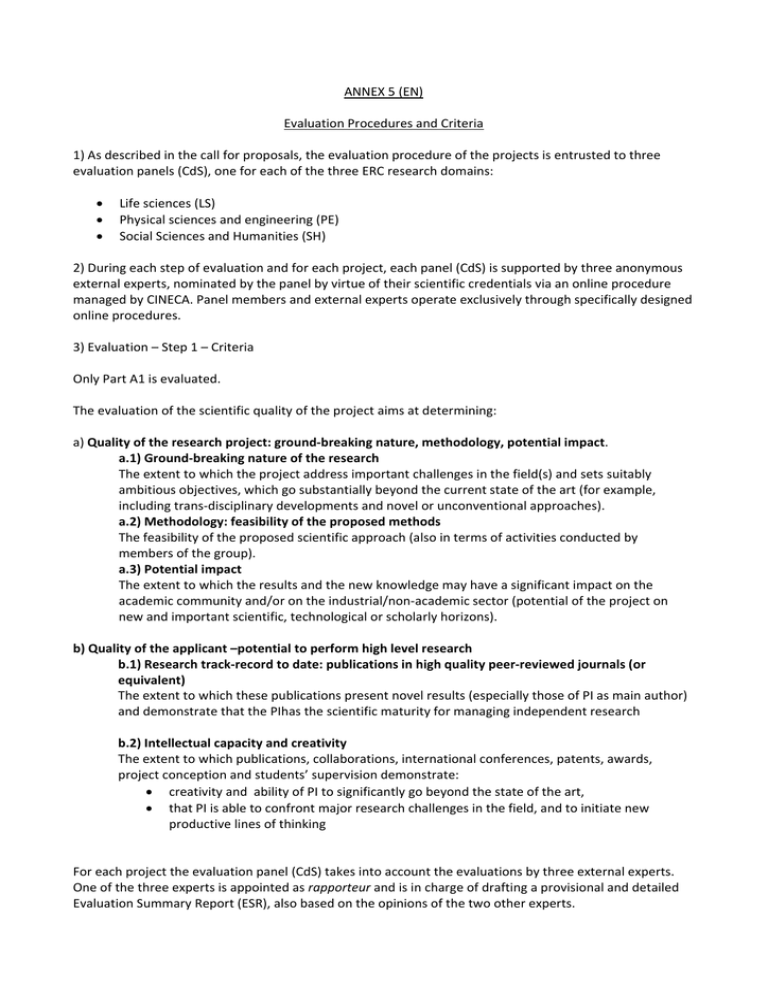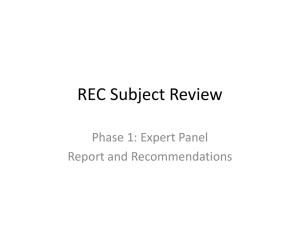ANNEX 5 (EN) Evaluation Procedures and Criteria
advertisement

ANNEX 5 (EN) Evaluation Procedures and Criteria 1) As described in the call for proposals, the evaluation procedure of the projects is entrusted to three evaluation panels (CdS), one for each of the three ERC research domains: Life sciences (LS) Physical sciences and engineering (PE) Social Sciences and Humanities (SH) 2) During each step of evaluation and for each project, each panel (CdS) is supported by three anonymous external experts, nominated by the panel by virtue of their scientific credentials via an online procedure managed by CINECA. Panel members and external experts operate exclusively through specifically designed online procedures. 3) Evaluation – Step 1 – Criteria Only Part A1 is evaluated. The evaluation of the scientific quality of the project aims at determining: a) Quality of the research project: ground‐breaking nature, methodology, potential impact. a.1) Ground‐breaking nature of the research The extent to which the project address important challenges in the field(s) and sets suitably ambitious objectives, which go substantially beyond the current state of the art (for example, including trans‐disciplinary developments and novel or unconventional approaches). a.2) Methodology: feasibility of the proposed methods The feasibility of the proposed scientific approach (also in terms of activities conducted by members of the group). a.3) Potential impact The extent to which the results and the new knowledge may have a significant impact on the academic community and/or on the industrial/non‐academic sector (potential of the project on new and important scientific, technological or scholarly horizons). b) Quality of the applicant –potential to perform high level research b.1) Research track‐record to date: publications in high quality peer‐reviewed journals (or equivalent) The extent to which these publications present novel results (especially those of PI as main author) and demonstrate that the PIhas the scientific maturity for managing independent research b.2) Intellectual capacity and creativity The extent to which publications, collaborations, international conferences, patents, awards, project conception and students’ supervision demonstrate: creativity and ability of PI to significantly go beyond the state of the art, that PI is able to confront major research challenges in the field, and to initiate new productive lines of thinking For each project the evaluation panel (CdS) takes into account the evaluations by three external experts. One of the three experts is appointed as rapporteur and is in charge of drafting a provisional and detailed Evaluation Summary Report (ESR), also based on the opinions of the two other experts. In order to facilitate the comparison between projects, the CdS should assign, as much as possible, the evaluation of projects belonging to the same sub‐sector to the same group of three experts or at least to the same rapporteur. However, the assignment of proposals to rapporteur should be limited, in general, to no more than 10‐12. In the provisional draft of the ESR, the rapporteur must rank each project in an evaluation class according to the following criteria: A – Excellent: fully convincing, without weaknesses. This applies to proposals that the scientific expert ranks approximately above the 95% of the projects the reviewer has experience of. B – Very Good: extremely strong with at most some minor weaknesses. This applies to proposals that the scientific expert ranks approximately between the 90% and 95% of the projects the reviewer has experience of. C – Good: strong but with some moderate weaknesses.This applies to proposals that the scientific expert ranks approximately between the 80% and 90% of the projects the reviewer has experience of. D – Fair: some important weaknesses. This applies to proposals that the scientific expert ranks approximately between the 50% and 80% of the projects the reviewer has experience of. E – Poor: not very convincing with numerous weaknesses. This applies to proposals that the scientific expert ranks approximately below 50% of the projects the reviewer has experience of. Each ESR must clearly highlight strengths and weaknesses of each project, with a view to helping the PI to submit better articulated and developed proposals in the future. 4) Evaluation – Step 1 –Ranks and Admission to Step 2 The evaluation panel (CdS) has the responsibility for validating the interim ESR, who can either confirm the rapporteur’s evaluation (in which case the ESR becomes definitive) or return the ESR to the rapporteur with observations, also based on comparison with ESRs of other projects. In comparing the ESRs, the evaluation panel (CdS) takes into account, the potentially abnormal distribution of projects in one or more of the classes indicated above. In any case, the panel (CdS) has the responsibility of assessingwhether the concentration of projects in each of the classes indicated is relevant for the proposal evaluation. If the rapporteur chooses to confirm her/his evaluation with adequate motivations, the evaluation panel (CdS) may take the ESR as definitive, or may otherwise proceed to draft an alternative, definitive ESR, providing adequate motivation for this action. Based on the final ESR classifications, each evaluation panel (CdS) allocates the proposals at one of the following levels: a. the proposal is of high quality and is eligible to go to Step 2 of the evaluation; b. the proposal is of good quality but not eligible to go to Step 2 of the evaluation; c. the proposal is not of sufficient quality to go to Step 2 of the evaluation. Proposals ranked in classes A and B will be in general allocated at level a. and therefore proceed to the second stage of evaluation. The evaluation panel (CdS) has the choice of admitting also projects ranked in class C, in full autonomy, using additional, documented objective criteria of admission. These criteria may be related to the limited or excessive concentration of proposals in one of the different classes. However, the number of proposals admitted to the second stage of evaluation should be such that the total amount of the requested grants is equal to or possibly higher(in case of equal ranking) three times the funds allocated in each research domain. 5) Evaluation – Step 2 – Criteria At this step, the complete version of proposals selected at Step 1 is evaluated. The evaluation of the scientific quality of the project aims at determining: a) Quality of the research project: ground‐breaking nature, methodology, potential impact. a.1) Ground‐breaking nature of the research The extent to which the project addresses important challenges in the field(s) and sets suitably ambitious objectives, which go substantially beyond the current state of the art (for example, including trans‐disciplinary developments and novel or unconventional approaches). a.2) Methodology: feasibility of the proposed methods The completeness, articulation and feasibility of the proposed research methodology (with reference, where necessary, to equipment, infrastructures etc.); the achievability of the objectives to an acceptable level within the expected time and available resources; the levels of risk of high innovation projects; the benefit/risk balance, intended as the relationship between the level of risk and challenging nature of the project; the importance of the project for the advancement of knowledge in the specific field. a.3) Potential impact The extent to which the results and the new knowledge may have a significant impact on the academic community and/or on the industrial/non‐academic sector (potential of the project on new and important scientific, technological or scholarly horizons). b) Quality of the applicant – potential to perform high level research b.1) Research track‐record to date: publications in high quality peer‐reviewed journals (or equivalent) The extent to which these publications are ground‐breaking (especially those of PI as main author) and demonstrate that PI have the scientific maturity for managing a completely independent research. What also needs to be evaluated is: a) the extent to which the project allows the applicant to make or consolidate the transition towards complete independence; b) the extent to which the project’s host institution can offer the equipment required to carry out the research, offering an adequate intellectual environment, infrastructure support and necessary assistance to help the project and the applicant achieve the desired objectives. b.2) Intellectual skills and creativity The extent to which publications, collaborations, international conferences, patents, awards, project conception and students’ supervision demonstrate: creativity and ability of PI to significantly go beyond the state of the art, that PI is able to tackle major research challenges in the field, and to initiate new productive lines of thinking At this stage and for each project, the evaluation panel (CdS) receives the evaluations elaborated by three external scientific experts. One of the three experts is appointed by the panel as rapporteur and is in charge of drafting a provisional and detailed Evaluation Summary Report (ESR), also based on the opinions of the two other experts. In order to facilitate comparison between the projects, the CdS should assign, as much as possible, the evaluation of projects belonging to the same sub‐sector to the same group of three experts or at least to the same rapporteur. However, the assignment of proposals to rapporteur should be limited, in general, to no more than 5‐6. In the provisional draft of the ESR, the rapporteur must rate each project according to the following criteria: 1) Very high quality projects: 28 to 30 points 2) High quality projects: 25 to 27 points 3) Lower quality projects: up to 24 points In any case, each ESR must clearly highlight strengths and weaknesses of each project, with a view to helping the PI to submit better articulated and developed proposals in the future. 6) Evaluation – Step 2 – Ethical and security review At Step 2 and parallel to the evaluation procedure, the panel (CdS) proceeds to an ethics review carried out by a specific team composed by at least three experts, either members or not of the panel and appointed by the panel. At the end of the review, the team declares the opportunity of funding the projects examined, also taking into account potentially non‐resolvable ethical issues. Similarly and again parallel to the evaluation procedure, the panel proceeds to a security analysis procedure carried out by a specific team composed by at least three experts, either members or not of the panel itself and appointed by the panel. At the end of the procedure the team declares the opportunity of funding the projects examined, also taking into account potentially non‐resolvable security issues. 7) Evaluation – Step 2 – ranking The evaluation panel (CdS) has the responsibility of the validation of the interim ESR, who can either confirm the rapporteur’s evaluation (in which case the ESR becomes definitive) or return the ESR to the rapporteur with observations, also based on comparison with ESRs of other projects. In comparing the ESRs, the evaluation panel (CdS) takes into account the potentially abnormal distribution of projects in one or more of the classes indicated above. If the rapporteur chooses to confirm her/his evaluation with adequate motivations, the evaluation panel (CdS) may take the ESR as definitive, or may otherwise proceed to draft an alternative, definitive ESR, providing adequate motivation for this action. At the end of the procedure, the evaluation panel (CdS) completes its work by classifying the projects according to the following levels and in strict observance of the scores attributed: a. the proposal fully meets the high quality criterion and can be recommended for funding within the available budget; b. the proposal mostly meets the high quality criterion and can be recommended for funding if sufficient funds are still available; c. the proposal meets some but not all the elements of the call for proposals and cannot be recommended for funding. In general, for each evaluation panel the number of projects ranking at level a. should be no more than 1/3 of the total of the projects selected for Step 2. However, each evaluation panel can autonomously decide additional, documented criteria to recommend a project for funding, according to the higher or lower number of proposals ranked at the different levels. 8) Interviews At the end of Step 2, the PIs ranking at a. level (and, in case of sufficient funds, also PIs ranking at a b. level, selected according to the higher scores) are invited to attend an interview at MIUR’s offices to present their projects to the evaluation panel. The interviews of approximately 30 minutes each aim at establishing the PI’s ability to autonomously manage the research projects. The first part is dedicated to the PI’s presentation of the research project. The remaining time is dedicated to a question and answer session. At the end of each interview, the evaluation panel drafts an evaluation report, indicating the reasons for confirming or altering the candidate’s rank. The budgets presented for each project are also evaluated; CdS can suggest changes for each item of expenditure, where appropriate, following the principles below: the cost of PIs contracts cannot be reduced; general expenses (item of expenditure B) cannot be a percentage different from 60% of congruous costs for item of expenditure A; it is not possible to reduce the financial contribution of other legal entities, where applicable; it is not advisable in general to reduce any item of expenditure by more than 20‐25% of what is indicated in the project.








